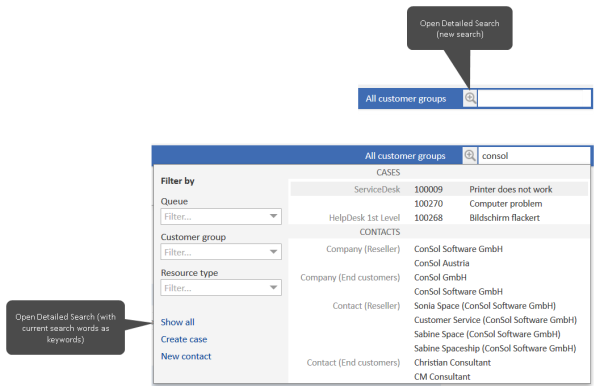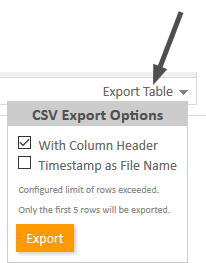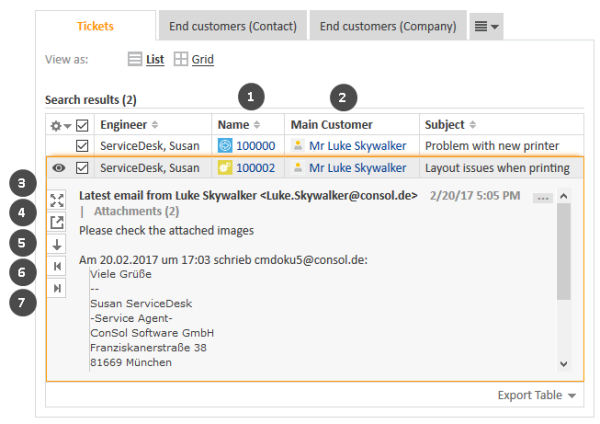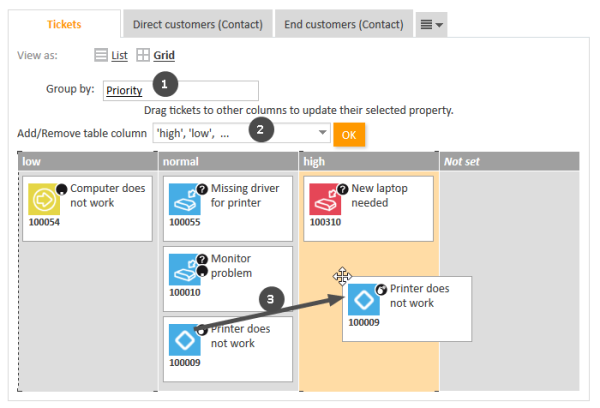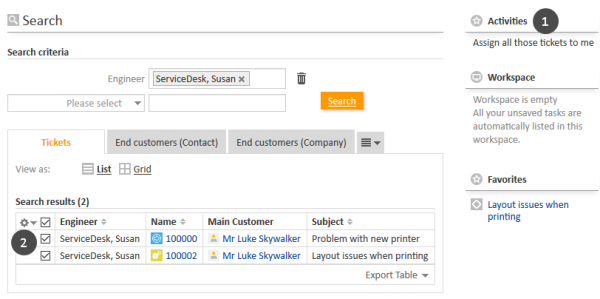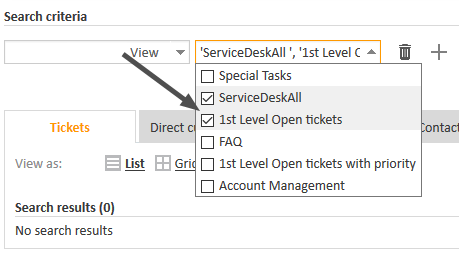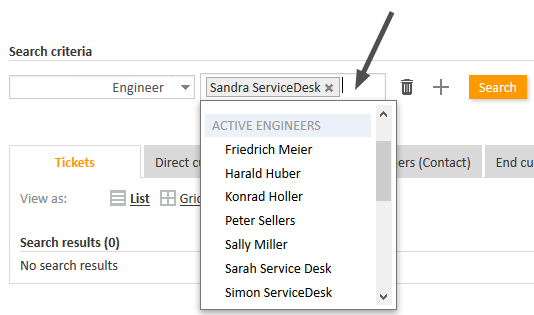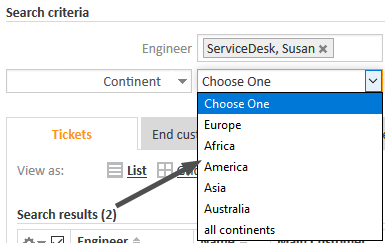Detailed Search
This chapter explains the features of the Detailed Search.
Introduction
The Detailed Search provides extensive search functionalities. You can use several search criteria. All the results are displayed in a table, where you can carry out additional actions.
You can access the Detailed Search by clicking the magnifying glass icon within the Quick Search or by clicking the Show all link below the Quick Search results. In the latter case, the search words from the Quick Search (including the implicitly present asterisk at the end of each word) are populated to the Free text (all fields, emails and comments) field.
Figure 15: Opening the Detailed Search
The Detailed Search enables you to search for cases, contacts, and resources using multiple search criteria. The Detailed Search simultaneously searches for cases and contacts. The tabs in the lower area of the Detailed Search allow you to choose if you want to show cases, contacts (grouped by customer groups unless you limit the results to specific customer groups using search criteria or the customer group filter), or resources.
A Detailed Search could be, for example, “Show only results with priority high”. In this case, the result list would contain:
- Cases with priority high
- Contacts who are the main contact or an additional contact for a case with the priority high
If you want to search for resources, you have to go to the Resources tab first and select the desired Resource type.
Every search criterion narrows down the search. Each search criterion is shown in a single row.
Figure 16: Detailed Search with three search criteria
Features of the Detailed Search
The following figure shows an example to illustrate the features of the Detailed Search.
Figure 17: Detailed Search
- Search criteria (1)
The results of the Detailed Search will match these criteria.Some search criteria allow you to choose one or several values from a drop-down list. Depending on your system configuration, a drop-down list can contain values displayed in italics. This means that the value is deactivated, i.e. it can be set in existing objects but you cannot set it anymore. It is still possible to search for objects with this value though.
In the field Free text (all fields, emails and comments) you can enter search terms (text, numbers) and use different search operators. Please take the following into account when using operators in the Free text (all fields, emails and comments) field.
- Do not use the search operators AND or OR. A space character already implies an AND relation between the search terms. An OR relation can only be established for certain search criteria when multiple selection is possible (see Relations between the search criteria below).
- You can use the asterisks search operator (*) as a placeholder for any number of characters.
- You can use the question mark search operator (?) as a placeholder for a single character.
- Recycle bin (2)
Click this button to delete a search criterion. - Plus icon (3)
Click this button to add a new search criterion. The new button Please select is displayed. You can choose the desired criterion from the list. Depending on the criterion, you can choose one or several values. - Search (4)
Click this button to perform the search with the current search criteria. - Deactivated incl. (5)
Select this checkbox if you want to show deactivated contacts or resources in the search results.The checkbox Deactivated incl. is only displayed if you clicked on a tab of a customer group or the Resources tab (see 6). If the tab for cases is chosen, the checkbox is not displayed.
- Use phonetic search (6)
Select this checkbox if you want to display search results which have a similar pronunciation but a different spelling, e.g. a search for the name Claire returns results for Claire, Clare, and Clair.The checkbox Use phonetic search is only displayed if the phonetic search is enabled for at least one field which belongs to the objects of the selected tab.
- Search result tabs (7)
Click the desired tab to switch between the results for cases, the results for the different customer groups, and the results for resources.When you switch to the Resources tab, any previously entered search criteria which do not apply to resources (e.g., Assignee, Process, or Status) are removed and you can only select relevant search criteria.
- Display hidden tabs (8)
This button is displayed if there are additional tabs which are not shown due to lack of space on the screen. Click this button to select the tab you want to display. - Column selection (9)
Click this button to choose which columns are displayed in the search results. - Search results (10)
In this section you see the results found in the search. - Number per page (11)
Click here to set the number of search results which should be displayed on each page. This option is only displayed if there are more than 10 search results.
You can add a Detailed Search to your Favorites to quickly access the Detailed Search itself or the cases matching its criteria.
Search criteria
The Detailed Search offers several search criteria. You can find a detailed description in the table below.
|
Search criteria
|
Description
|
|---|---|
|
Free text (all fields, emails and comments) / Free text (all fields) |
Searches for free text in cases and contacts. |
| Archived | Searches for archived or non-archived cases. |
|
Close date |
Searches for cases which have been closed in a specified date range. |
|
Creation date |
Searches for cases which have been created in a specified date range. |
|
Assignee |
Searches for cases which are assigned to one or several selected users, unassigned cases, or assigned cases. |
|
Process |
Searches for cases which are in one or several selected processes. |
|
Referenced assignees |
Searches for cases which have one or several selected additional assignees. You can narrow down the search to find only cases where the selected user has a specific function, or cases which have a certain approval status. |
|
Status |
Searches for open cases or for closed cases. |
|
Subject |
Searches for a keyword from the case subject. |
|
View |
Searches for cases which are shown in one or several views from the case list. |
|
Case fields |
The searchable case fields are listed by case field group. Depending on the field type, you can select a value from a list, select a date, or enter a keyword. The available case fields depend on the individual configuration of your CM system. |
|
Company |
Opens an autocomplete field where you can select a company. |
|
Person |
Opens an autocomplete field where you can select a person. |
|
Customer group |
Searches for contacts belonging to one or several selected customer groups. |
|
Contact fields |
The searchable contact fields are listed by contact data model. Depending on the field type, you can select a value from a list, select a date, or enter a keyword. The available contact fields depend on the individual configuration of your CM system. |
|
Resource type |
This search criteria is only available if you clicked the Resources tab. Select a resource type to limit the display of the available resource fields. |
|
Resource fields |
The searchable resource fields are determined by the selected resource type. Depending on the field type, you can select a value from a list, select a date, or enter a keyword. The available resource fields depend on the individual configuration of your CM system. |
When you search for cases, you can switch to a contact tab to see the contacts which belong to the cases you found. In the same way, you can switch to the Cases tab to see the cases of the contacts you have found.
Working with the search results
You can perform several actions with the results of a Detailed Search. It is possible to change the display of the results table by adjusting the table columns or displaying the results as a grid. In addition you can export the search results, open a search result or carry out a search activity.
Exporting the search results
You can export the search results to a CSV file. Below the Search results table, there is a link Export Table. There you can choose whether you want the file to have a header row and a timestamp and start the export.
By default, the export can contain up to 500 rows.
Adjusting the table columns
You can resize the table columns by dragging each column to the desired width. This allows you to adapt the table display to the content, e.g. to show long case subjects.
You can determine the columns which the result table should contain. To do so, click the little arrow next to the wheel icon. You can remove existing columns by clicking the cross next to the column name. To add new columns, click in the white space next to the names of the displayed columns to see a list of all available columns, or start typing the column name and click one of the suggested columns. Select the desired columns which should be additionally displayed. You can rearrange the columns within the Search results table by dragging-and-dropping each column to the desired position.
Figure 18: Selecting the columns in a Detailed Search
Your column configuration is saved when you add the Detailed Search to the Favorites.
Opening a case, contact, or resource
The search results on the Contacts tabs lead you directly to the respective contact pages. If you click a search result, the respective contact page (company or person) is opened automatically. The same applies to resources in the Resources tab.
The Cases tab allows you to open either the case or the contact page. If there is a column containing the case's main contact, you can click the name of the contact, which is a link, to open the respective contact page. In the same way, there can also be a column containing a link to the case. If you click another column, the case preview is opened within the Search results table. You can then open the case or switch to the preview of the next case in the list.
It depends on the individual configuration of your CM system if the case preview is available.
The case preview always shows the case's last comment or email. The following features are available:
Figure 19: The case preview
- (1) Link to open the case
- (2) Link to open the case's main contact
- (3) Button to show more details in the preview
- (4) Button to open the case in a new browser tab
- (5) Button to switch to the preview of the next result
- (6) Button to open a preview of the previous attachment (only attachments included in the last comment or email)
- (7) Button to open a preview of the next attachment (only attachments included in the last comment or email)
Viewing the search results as a grid
On the Cases tab, you can also display the search results as a grid. To do so, click the Grid button next to View as. In the grid view you can select a criterion to group the results (1).Initially, there will be one column for each active value of the grouping criterion. You can configure the displayed columns by selecting the desired columns in the Add/Remove table column field (2) (for grouping by assignee: Add/Remove assignee). Deactivated values are not shown by default, but you can still select them from the drop-down list, where they are displayed in italics. You can drag-and-drop cases from one column to another to update this value in the case (3). You cannot drag-and-drop a case into a column with a deactivated value though.
Figure 20: Viewing the results of a Detailed Search as a grid
Performing search activities
Depending on the tab, one or several search activities might be available under Activities (1). Search activities are defined for each result type, i.e., when you view the Cases tab, you see other search activities than when you view the tab of a customer group. Click the desired activity to execute it. Please bear in mind that search activities are usually executed on all the results which are displayed in the Search results table at the moment and which have been selected using the respective checkbox (2). If there are several pages of search results, only the current page is considered.
The specific behavior of each search activity depends on the individual configuration of your CM system. Your CM administrator might, for example, determine that all the results from all table pages are considered for the search activity, or that certain results are excluded because they do not meet a given condition.
Figure 21: Available activities for the Detailed Search
Search activities can have a form which needs to be filled out before proceeding. See Forms for activities for further information. The data entered in the form is usually applied to all selected search results.
Relations between the search criteria
AND relation
All search criteria of the Detailed Search are connected with each other via an AND relation. For example, the search criteria “Assignee: ServiceDesk, Susan” and “Customer group: MyContactGroup” provide search results which match both search criteria:
- Cases which are assigned to Susan ServiceDesk and have the main contact or at least one additional contact from the customer group MyContactGroup.
- Contacts who belong to the customer group MyContactGroupand are a main contact or additional contact of at least one case assigned to Susan ServiceDesk.
Figure 22: AND relation with different search criteria
In contrast to previous ConSol CM versions, two search criteria which are columns of the same table are also connected with AND. If you search a table containing the names of persons for Martin in the First name column and Smith in the Last name column, you only find objects where the table contains a row with the values Martin and Smith.
OR relation
Within a single search criterion there can be OR relations. When an OR relation is possible, the search criterion allows for multiple selections, i.e., you can choose any number of checkboxes from the drop-down menu. The choices for this criterion are displayed as a comma-separated list. For example, when the search criterion “View: ServiceDeskAll, 1st Level Open cases” is chosen, the results will contain cases and contacts from the view ServiceDeskAll as well as cases and contacts from the view 1st Level Open cases.
Figure 23: OR relation within one search criterion
Another possibility for OR relations are search fields, where you can select one item from the list and click again to select another item.
Figure 24: OR relation within one search criterion
If an OR relation is not possible, there is only one possible choice from a list in the drop-down menu:
Figure 25: No OR relation within one search criterion possible
FAQs
Which cases do I find via Detailed Search?
You can find via Detailed Search all cases which are currently in processes for which you at least have read permission and which have a main contact from a customer group for which you at least have read permission (see Visibility of cases). The Detailed Search shows open cases as well as already closed cases (unless you excluded one of them using the search criterion Status).
Which contacts do I find via Detailed Search?
You can find via Detailed Search all contacts which are in customer groups for which you at least have read permission (see Visibility of contacts).
The search results are limited to the customer group selected in the customer group filter in the main menu. If it is set to All customer groups the search will return results for all customer groups. Otherwise, only contacts belonging to the selected group will be found.
The checkbox Deactivated incl. allows you to search for deactivated contacts. It is only displayed if you are on a tab which shows search results for a customer group.
Which resources do I find via Detailed Search?
You can find via Detailed Search all resources for whose resource type you have at least read permission (see Visibility of resources).
The checkbox Deactivated incl. allows you to search for deactivated resources. It is only displayed if you are on the Resources tab.
